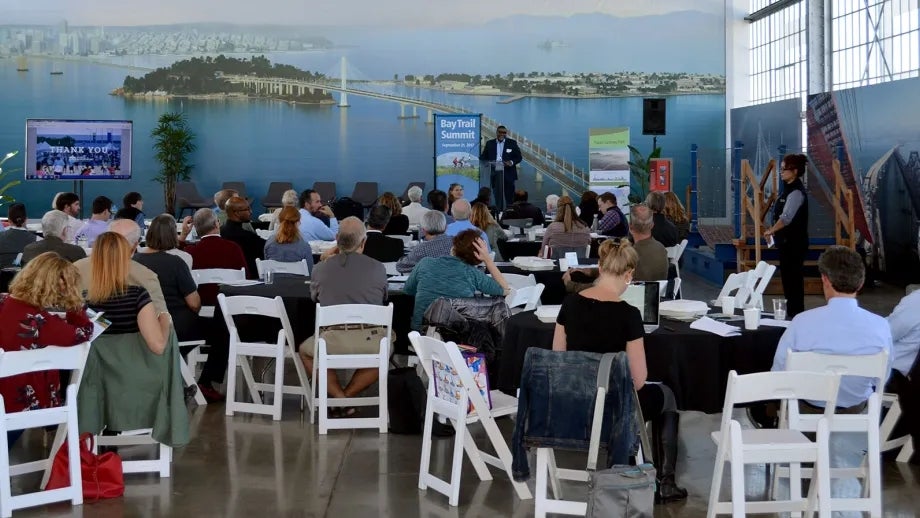Bay Trail Summit: Envisioning a Complete Bay Trail
Bay Area planners, advocates and decision-makers gathered in late September to discuss a vision they all share for a completed Bay Trail — 500 continuous miles of shoreline paths ringing the entirety of San Francisco Bay and serving as both a recreation and transportation corridor for bicyclists and pedestrians and as a strong economic generator for the region.
The inaugural Bay Trail Summit was held at a landmark along the San Francisco Bay Trail: the historic and newly restored Bridge Yard building at the Oakland touchdown of the East Span of the new San Francisco-Oakland Bay Bridge, and an access point for walking or cycling the bicycle/pedestrian path across the East Span.
The Summit was a time to pause and take stock of the remarkable progress to date, and to find a way forward toward the next set of milestones. Already 70 percent complete, the Bay Trail boasts more than 350 miles of paths, and crosses four-and-a-half of the region’s eight toll bridges. The “half” accounts for the path on the East Span of the Bay Bridge but not on the West Span; an MTC-financed study is looking at extending the path all the way to San Francisco from its current terminus at Yerba Buena Island — a technically tricky and expensive proposition.
The reality is that it is the “easy” sections of the trail that have been built, and it is the more challenging sections that remain. And those unbuilt sections are challenging for many reasons, including restricted rights-of-way, inadequate funding and the need to balance creating public waterfront access with protecting sensitive habitats.
“The Bay Trail project is a completely audacious idea,” noted San Francisco Bay Trail Project Chair John Woodbury. “We wanted a trail that circles the entire Bay, and we wanted it for everyone — senior citizens, birdwatchers, commuters. And so far we’ve managed to build 70 percent of it!” Woodbury noted that the proliferation of new development along the shoreline has actually helped to advance construction of the trail, since Bay Conservation and Development Commission (BCDC) regulations require that “thou shalt provide public access to the waterfront.” (The quote is Woodbury’s and not in BCDC statute, though the general sentiment is.)
The East Bay Regional Park District hosted the Bay Trail Summit to energize decision-makers and trail advocates, and to provide a forum for East Bay leaders to discuss creative ways to advance and fund the trail through its final phases. The Bay Trail is a primary project in the East Bay Regional Park District’s Master Plan, and the Park District has built — and continues to build — many miles of Bay Trail across 21 shoreline parks and open spaces in Alameda and Contra Costa counties. And while the Summit’s focus was on the trail segments in Oakland and the East Bay, the ideas that came out of it apply to the entire trail system.
Keynote speaker William Smith of the Detroit River Conservancy described his city’s inspiring transformation of a neglected 5.5-mile section of Detroit waterfront into a hub of activity and a focus of community pride. Oakland and Detroit share parallels: Both are waterfront cities with strong industrial bases that have a desire to reconnect with their shorelines. According to Smith, the Detroit River Conservancy hosts or supports regular events that activate their waterfront, including a “River Walkers” weekly walk, rain water collection workshops, moonlight yoga and a fishing fest where the state police teach city kids how to fish.
Following the keynote, a panel discussion of Bay Area business leaders, developers and trail advocates discussed topics ranging from the need for continued investment in the Bay Trail and the various opportunities for public-private partnerships, to the value of Bay Trail to businesses and employees, and the importance of education and widespread enthusiasm for completing the trail.
It’s likely, however, to be an uphill ride to reach the vision shared by Summit attendees. It will cost over $220 million to complete the remaining gaps in the Bay Trail, not including the toll bridge pathways. And although several existing and potential funding sources exist — Measure AA from the Bay Area Restoration Authority, a potential ballot measure to raise bridge tolls (Regional Measure 3) and a possible Park Bond (SB5) — it will take public support, focused leadership, political will and persistence to find the necessary funding to close the remaining gaps.
“We do better as a region when we work together,” noted Woodbury during his remarks. And the Bay Trail up until now has been a regional initiative like no other. Many partners have come together since the Bay Trail Plan was launched in 1989 to do their part to help complete a shoreline trail in all nine Bay Area counties, through 47 cities.
MTC is a long-time supporter and funder of the Bay Trail program, and is committed to advancing the Bay Trail through continued funding of operations, improving bicycle and pedestrian approaches to pathways on the toll bridges, continuing to recognize this resource as a valuable recreation and transportation corridor in Plan Bay Area, and working with partners to position remaining trail gaps for a variety of funding sources. With the recent consolidation of MTC and Association of Bay Area Governments staff, MTC now also includes the San Francisco Bay Trail Project staff. MTC oversaw the renovation of the Bridge Yard building, and financed it with bridge tolls.


Submit your comment
In order to receive a reply to your comment, please provide an email address.